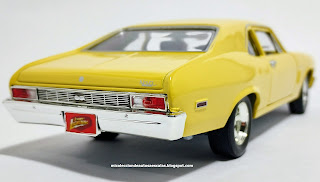El Chevrolet Camaro es un automóvil deportivo de dos puertas, con motor delantero montado longitudinalmente y de tracción trasera, producido por el fabricante estadounidense Chevrolet, división de General Motors (GM) desde 1966. Compartía su plataforma y la mayoría de sus componentes con el Pontiac Firebird, también introducido en 1967.
Se clasifica como un pony car y en algunas versiones también como un muscle car. Surgió como la respuesta de GM al creador del segmento de los "pony cars": el Ford Mustang.
En plena era de los "pony cars", Chevrolet presentó este modelo en dos versiones: el Camaro Rally Sport (RS) y el Camaro Super Sport (SS). Este último contaba con un motor V8 de 350 pulgadas cúbicas (5,7 litros) y otro opcional de 396 plg³ (6,5 litros), los cuales estaban hechos para la clase de cliente estadounidense apasionado por los Big Macs, con la idea de "comer en el verano e hibernar en el invierno", ya que se fabricaba tanto en versión cupé como en descapotable. Esta tradición jamás continuó a pesar de la gran decadencia a mediados de los años 1970 con la subida del precio de los combustibles, provocada por la Crisis del petróleo de 1973. Este modelo se hizo famoso en las carreras de Trans-Am y en la National Hot Rod Association (NHRA).
Fue mostrado por primera vez en un preestreno para la prensa en Detroit (Míchigan), el 12 de septiembre de 1966 y más tarde en Los Ángeles (California). Estuvo oficialmente a la venta en los concesionarios a partir del 29 de septiembre de 1966. Fue presentado como el modelo del año en 1967, compartiendo el diseño del bastidor delantero / semi-monocasco con el Chevy Nova de 1968. Estaban disponibles casi 85 opciones de fábrica y 40 opciones de concesionario, incluyendo tres paquetes principales.
El RS Rally Sport era un paquete de apariencia más deportiva que incluía faros escamoteables, luces traseras modificadas, emblemas RS y molduras laterales bajas cromadas, el cual estaba disponible en todos los modelos.
El paquete SS incluyó un motor V8 de 350 plg³ (5,7 litros) L48 con un carburador de cuatro bocas Quadrajet de 750 pies cúbicos por minuto (21,2 m³/min) y una relación de compresión de 10.25:1. Otros eran los de 396 plg³ (6,5 litros) L35 con 325 HP (330 CV; 242 kW) y el opcional L78 con un carburador de cuatro bocas Holley 4150 de 800 cuft/min (22,7 m³/min) y una relación de compresión de 11.0:1 que producía 375 HP (380 CV; 280 kW), del bloque grande similar al Corvette, pero con menor cilindrada también estaban disponibles. El SS ofrecía tomas de aire en el cofre no funcionales, franjas laterales especiales e insignias SS en la parrilla, guardabarros delanteros, tapa de la gasolina y botón de la bocina. Era posible pedir tanto el SS y RS para recibir un Camaro RS/SS. En 1967, un Camaro RS/SS convertible con un motor de 396 plg³ (6,5 litros) estableció el paso de la carrera de las 500 millas de Indianápolis.

























































